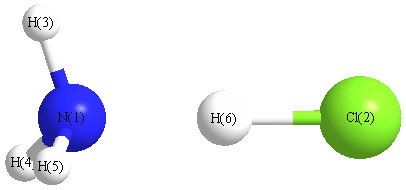Vibrational Frequencies calculated at BLYP/daug-cc-pVTZ
| Mode Number |
Symmetry |
Frequency
(cm-1) |
Scaled Frequency
(cm-1) |
IR Intensities
(km mol-1) |
Raman Act
(Å4/u) |
Dep P |
Dep U |
|---|
| 1 |
A1 |
3369 |
3369 |
0.00 |
|
|
|
| 2 |
A1 |
1992 |
1992 |
2307.04 |
|
|
|
| 3 |
A1 |
1083 |
1083 |
83.53 |
|
|
|
| 4 |
A1 |
194 |
194 |
41.63 |
|
|
|
| 5 |
E |
3485 |
3485 |
15.10 |
|
|
|
| 5 |
E |
3485 |
3485 |
15.10 |
|
|
|
| 6 |
E |
1622 |
1622 |
21.06 |
|
|
|
| 6 |
E |
1622 |
1622 |
21.05 |
|
|
|
| 7 |
E |
830 |
830 |
22.60 |
|
|
|
| 7 |
E |
830 |
830 |
22.60 |
|
|
|
| 8 |
E |
250 |
250 |
12.02 |
|
|
|
| 8 |
E |
250 |
250 |
12.02 |
|
|
|
Unscaled Zero Point Vibrational Energy (zpe) 9506.4 cm
-1
Scaled (by 1) Zero Point Vibrational Energy (zpe) 9506.4 cm
-1
See section
III.C.1 List or set vibrational scaling factors
to change the scale factors used here.
See section
III.C.2
Calculate a vibrational scaling factor for a given set of molecules
to determine the least squares best scaling factor.
Charges, Dipole, Quadrupole and Polarizability
Charges from optimized geometry at BLYP/daug-cc-pVTZ
Charges (e)
| Number |
Element |
Mulliken |
CHELPG |
AIM |
ESP |
| 1 |
N |
-0.169 |
|
|
|
| 2 |
Cl |
-0.689 |
|
|
|
| 3 |
H |
0.144 |
|
|
|
| 4 |
H |
0.144 |
|
|
|
| 5 |
H |
0.144 |
|
|
|
| 6 |
H |
0.425 |
|
|
|
Electric dipole moments
Electric dipole components in Debye
(What's a Debye? See section
VII.A.3)
| |
x |
y |
z |
Total |
| |
0.000 |
0.000 |
-4.819 |
4.819 |
| CHELPG |
|
|
|
|
| AIM |
|
|
|
|
| ESP |
|
|
|
|
Electric Quadrupole moment
Quadrupole components in D Å
| Primitive |
|---|
| | x | y | z |
|---|
| x |
-20.719 |
0.000 |
0.000 |
| y |
0.000 |
-20.719 |
0.000 |
| z |
0.000 |
0.000 |
-15.898 |
|
| Traceless |
|---|
| | x | y | z |
|---|
| x |
-2.410 |
0.000 |
0.000 |
| y |
0.000 |
-2.410 |
0.000 |
| z |
0.000 |
0.000 |
4.821 |
|
| Polar |
|---|
| 3z2-r2 | 9.641 |
|---|
| x2-y2 | 0.000 |
|---|
| xy | 0.000 |
|---|
| xz | 0.000 |
|---|
| yz | 0.000 |
|---|
|
Polarizabilities
Components of the polarizability tensor.
Units are
Å
3 (Angstrom cubed)
Change units.
| |
x |
y |
z |
| x |
4.710 |
0.000 |
0.000 |
| y |
0.000 |
4.710 |
0.000 |
| z |
0.000 |
0.000 |
7.365 |
<r2> (average value of r
2) Å
2
| <r2> |
78.954 |
| (<r2>)1/2 |
8.886 |
